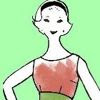
"At the beginning of each season, make a critical survey of all of the clothing you have on hand, including dresses, coats, suits, blouses, skirts, and the smaller accessories. Do not make merely a mental review, but take the garments into a good light where you can study them. Make yourself ready as though you were going out, arranging your hair becomingly and wearing a well-fitted corset, underwear that conforms with the fashionable silhouette, and good street or dress shoes. Then try on each garment in turn, and observe its lines in relation to the current fashion. Note particularly what parts need to be changed or freshened, and determine whether or not cleaning is necessary and whether adding a new piece of lace or a frill, or taking off the belt, or adding a new one would remove a worn or unseasonable appearance. Simply diagnose the case of each garment-dissect it, so to speak, and note just how it may best be improved, or where a touch of becoming, seasonable color would add to its appearance."
"Necklines - The most common necklines are round, bateau (boat shape), square, V shape, and surpliced, which is just a variation of the V neck. Much variety is possible with these shapes by using collars of different types, or by leaving the neck line collarless. A high neck line may be changed by cutting it lower. A low neck line may be built up by inserting fitted pieces and covering them with a collar, or by changing the shape, if necessary, and filling it in with a yoke of lace or chiffon or softly shirred net or tulle. The addition of a scarf often proves sufficient change if the neck line is not definitely out of style. Figs. 7 and 8 offer suggestions for various neck finishes."
"The effect of a whole dress may be changed by changing its neck line. So, study the prevailing fashion in neck lines, in order that any changes you make will be fashionable. Also, before making changes, study your own type with a view to determining the most becoming shape."
"Sleeve Changes-Sleeves date a dress by their length and their fulness. Short sleeves may be made long by the addition of transparent or heavily embroidered sleeves in bishop effect, or by joining a section of self-material and covering the joining with tucks or some other trimming feature. Three-quarter-length sleeves may be changed by the addition of full, lacy sleevelets, by adding deep cuffs, or by joining sections of self-material as just suggested for short sleeves. Or, if short sleeves are preferred, long ones may be cut off and finished to harmonize with the dress. Narrow sleeves may be increased in width by slashing them and inserting material that matches or contrasts. Plaiting this section often takes the curse off a change of this kind by removing the mark of necessity. Fig. 9 shows a variety of sleeves that offer many suggestions."
"...removing the mark of necessity..."
I just like the sound of that phrase.
"Changing Waist Lines - The waist line is probably the most difficult feature of a dress to alter satisfactorily without entirely recutting the whole garment. It may offend by being too high or too low, too tight or too loose. Of course, if the position of the waist line is due entirely to the placing of a loose belt, the belt can be raised or lowered very easily. But if the dress is cut across tt the waist line, the matter assumes a different aspect. If a high or normal waist line of this kind is to be lowered and there is available material, a wide, straight band, perhaps on the opposite grain, may be added to the bottom of the blouse. As a rule, however, recutting is the only remedy.
A waist line that is too low may be cut higher, provided there is some means of adding more length to the skirt. Just what this means should be depends entirely on the type of the dress.
When waist lines are drawn in too tightly, it is usually possible to let out some fulness and so produce a newer effect. If, on the other hand, the dress falls too loosely over the waist line, draw it in with a belt or with gathers, tucks, or plaits, or by taking in some of the material in the seams.
If the waist line is neither too high nor too low, too tight nor too loose, but still a change seems desirable, the suggestions in Fig. 10 should prove helpful. Two hem finishes, which may be repeated on the sleeve, cuff, neck, collar or as a waist-line trimming, are shown at the right and left of the center of this illustration.
Now, as to Budgeting...why, it's patriotic!

" Much discussed topics, like much discussed persons, sometimes become very unpopular. Yet many of them, like many persons, have enough individual value eventually to achieve standing on sheer merit. Such has been the case with budgeting, which is becoming an increasingly important factor in American individual and family, as well as national, life. The thoughtful person must realize that community, and even national, waste can be traced back to wrong standards of spending and the unsystematic use of resources in family and individual life. It follows, inevitably, that the place to apply the remedy is at the source of the trouble. Viewed in this light, budgeting becomes a privilege-an opportunity for every person, as a good citizen, to advance his interests and at the same time to help in making the position of the nation more secure."
I hope you enjoyed this trip back in time...I did!


Loved this! The sleeves are fantastic! And I love the bit at the end about budgeting!
ReplyDelete